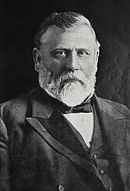1896 New Zealand general election
| |||||||||||||||||||||||||||||||||||||
All 74 seats in the New Zealand House of Representatives 38 seats were needed for a majority | |||||||||||||||||||||||||||||||||||||
|---|---|---|---|---|---|---|---|---|---|---|---|---|---|---|---|---|---|---|---|---|---|---|---|---|---|---|---|---|---|---|---|---|---|---|---|---|---|
| Turnout | 76.1% | ||||||||||||||||||||||||||||||||||||
| |||||||||||||||||||||||||||||||||||||
| |||||||||||||||||||||||||||||||||||||
The New Zealand general election of 1896 was held on Wednesday, 4 December in the general electorates, and on Thursday, 19 December in the Māori electorates to elect a total of 74 MPs to the 13th session of the New Zealand Parliament. A total number of 337,024 (76.1%) voters turned out to vote.[1]
1896 was the year the limit of £200 was placed on each candidate's campaign spending.
Background
The Liberal government campaigned on a platform that the election was between the people and the "selfish few". The economy stagnated, raising unemployment, which caused support for the Liberals to fall in the cities and they lost many seats, though not enough to be removed from office by the Conservatives. In rural areas, the swing in support was not as large due to the public works and land settlement programmes helping to support the regions.[2] In June 1896 Seddon had replaced Joseph Ward as Finance Minister whilst the latter had resigned after being declared temporarily bankrupt. As such Seddon himself took on the workload of the treasury making him more susceptible to opposition attacks over the economy. He proved to be a cautious financier, budgeting for surpluses while maintaining the spirit of self reliance his predecessor John Ballance had advocated.
Results
Party totals
The following table gives party strengths and vote distribution according to Wilson (1985), who records Maori representatives as Independents prior to the 1905 election.[3]
style="width: 2px; color:inherit; background-color: #FFDF00;" data-sort-value="New Zealand Liberal Party" | style="width: 2px; color:inherit; background-color: #9999CC;" data-sort-value="Conservative (New Zealand)" | style="width: 2px; color:inherit; background-color: #DCDCDC;" data-sort-value="Independent politician" || Election results | ||||||
|---|---|---|---|---|---|---|
| Party | Candidates | Total votes | Percentage | Seats won | Change | |
| Liberal | 81 | 184,650 | 54.78% | 39 | -12 | |
| Conservative | 70 | 114,574 | 33.99% | 26 | +13 | |
| Independent | 60 | 37,800 | 11.23% | 9 | -1 | |
Votes summary
Template:1896 New Zealand general election
The election of Thomas Wilford for the electorate of Suburbs of Wellington was declared void by an election petition on the grounds of corrupt and illegal practices. Charles Wilson was elected MP for that electorate following a by-election on 23 April 1897.
Summary of changes
- A boundary redistribution resulted in the abolition of seven seats:
- Chalmers, held by John A. Millar
- Inangahua, held by Patrick O'Regan
- New Plymouth, held by Edward Smith
- Pareora, held by Frederick Flatman
- Rangitata, held by William Maslin
- Waimea-Sounds, held by Charles Mills
- Waipa, held by Frederic Lang
- At the same time, seven new seats came into being:
Notes
- ^ "General elections 1853-2005 - dates & turnout". Elections New Zealand. Archived from the original on 14 November 2014. Retrieved 11 January 2011.
- ^ Hamer 1988, p. 231.
- ^ Wilson 1985, pp. 287–289.
References
- Wilson, James Oakley (1985) [First ed. published 1913]. New Zealand parliamentary record, 1840–1984 (4 ed.). Wellington: V.R. Ward, Govt. Printer. OCLC 154283103.
- Hamer, David A. (1988). The New Zealand Liberals: The Years of Power, 1891–1912. Auckland: Auckland University Press. ISBN 1-86940-014-3.
{{cite book}}: Invalid|ref=harv(help)


